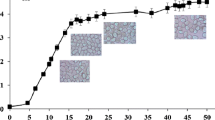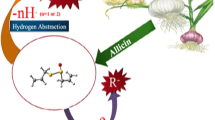Abstract
The antioxidative action of amphiphilic mono-(alkanoylamino) ethyldimethylamine-N-oxides (EDA), di-N-oxides 1,1-bis{[2-(N,N-dimethylamino)ethyl]amido}alkane-di-N-oxides (MEDA) and 1,1-bis {[3-(N,N-dimethylamino)propyl]amido}alkane-di-N-oxides (MPDA) with a 12- and 14-membered acyl chain againsttert-butylhydroperoxide (TBHP)-produced peroxyl and paraquat (PQ)-generated superoxide radicals was determined in superoxide dismutase-deficient mutants ofSaccharomyces cerevisiae, and, in parallel, in a chemical assay based on chemiluminescence changes caused in a luminol system by peroxyl radicals generated from the azo-compound 2,2′-azobis(2-amidinopropane dihydrochloride) (AAPH). At 30 µmol/L, the shorter-chain compounds did not affect strain survival while longer-chain ones, in some cases, lowered the survival ofsod2 andsod1 sod2 cells. Whether nontoxic or medium-toxic, allN-oxides protected thesod strains against the toxic effect of PQ and TBHP, the protection being stronger with the di-N-oxides. The survival was lowered only by 14-MPDA in the TBHP-exposedsod2 mutant. Membrane lipids isolated from all strains were protected against TBHP-induced peroxidation by both mono- and di-N-oxides, the protection being dependent on the alkyl chain length. Mono-N-oxides were again less active than di-N-oxides with the same alkyl chains, the antiperoxidative activity being also dependent on lipids isolated from the individual mutants. In the chemiluminescence assay, the IC50 value of theN-oxides for scavenging of radicals generated from AAPH generally decreased (i.e. the scavenging efficiency increased) with increasing chain length and was the highest in MEDA.
Similar content being viewed by others

Abbreviations
- AAPH:
-
2,2′-azobis(2-amidinopropane) dihydrochloride
- IC50 :
-
antioxidant concentration that reduces luminol luminescence to 50 %
- EDA:
-
2-(alkanoylamino)ethyldimethylamine-N-oxides;see Fig. 1
- MEDA:
-
1,1-bis{[2-(N,N-dimethylamino)ethyl]amido}alkane-di-N-oxides;see Fig. 1
- MPDA:
-
1,1-bis{[3-(N,N-dimethylamino)propyl]amido}alkane-di-N-oxides;see Fig. 1
- PDA:
-
3-(alkanoylamino)propyldimethylamine-N-oxides;see Fig. 1
- PQ:
-
paraquat
- ROS:
-
reactive oxygen species
- SOD:
-
superoxide dismutase (EC 1.15.1.1)
- SUV:
-
small unilamellar vesicles
- TBA:
-
thiobarbituric acid
- TBHP:
-
tert-butylhydroperoxide
- TBRS:
-
thiobarbituric acid-reactive substances
- TMA-DPH:
-
N,N,N-trimethyl-4-(6-phenyl-1,3,5-hexatrien-1-y1)phenylammonium 4-toluenesulfonate
References
Anderson R.F., Shinde S.S., Hay M.P., Denny W.A.: Potentation of the cytotoxicity of the anticancer agent triapazamine by benzotriazineN-oxides: the role of redox equlibra.J.Am.Chem.Soc. 128, 245–249 (2005).
Aust S.D.: Thiobarbituric acid assay reactants.Meth.Enzymol. 1, 225–223 (1994).
Balzi E., Chen W., Ulaszewski S., Capieaux E., Goffeau A.: The multidrug resistance gene PDR1 fromSaccharomyces cerevisiae.J.Biol.Chem. 262, 16871–16879 (1987).
Blough N.V.: Electron paramagnetic resonance measurements of photochemical radical production in hemic substances. 1. Effect of O2 and charge on radical scavenging by nitroxides.Environ.Sci.Technol. 22, 77–82 (1988).
Damiani E., Castagna R., Astolfi P., Greci L.: Aromatic and aliphatic mono- and di-nitroxides: a study on their radical scavenging abilities.Free Radical Res. 39, 325–336 (2005).
Damiani E., Astolfi P., Cionna L., Ippoliti F., Greci L.: Synthesis and application of a novel sunscreen-antioxidant.Free Radical Res. 40, 485–494 (2006).
Dufour J.P., Amory A., Goffeau A.: Plasma membrane ATPase from the yeastSchizosaccharomyces pombe.Meth.Enzymol. 157, 513–528 (1988).
Goldstein S., Samuni A., Hideg K., Merenyl G.: Structure-activity relationship of cyclic nitroxides as SOD mimics and scavengers of nitrogen dioxide and carbonate radicals.J.Phys.Chem. 110, 3679–3685 (2006).
Jemioła-Rzeminska M., Kruk J., Skowronek M., Strzalka K.: Location of ubiquinone homologues in liposome membranes studied by fluorescence anisotropy of diphenyl-hexatriene and trimethylammonium-diphenyl-hexatriene.Chem.Phys.Lipids 79, 55–63 (1996).
Kleszczynska H., Bonarska D., Pruchnik H., Bielecki K., Piasecki A., Luczynski J., Sarapuk J.: Antioxidative activity of newN-oxides of tertiary amines: membrane model and chromogen studies.Z.Naturforsch. 60, 567–571 (2005).
Krasowska A., Dziadkowiec D., Łukaszewicz M., Wojtowicz K., Sigler K.: Effect of antioxidants onSaccharomyces cerevisiae mutants deficient in superoxide dismutases.Folia Microbiol. 48, 754–760 (2003).
Krasowska A., Chmielewska L., Gapa D., Prescha A., Váchová L., Sigler K.: Viability and formation of conjugated dienes in plasma membrane lipids ofS. cerevisiae, S. pombe, R. glutinis, andC. albicans exposed to hydrophilic, amphiphilic and hydrophobic pro-oxidants.Folia Microbiol. 47, 145–151 (2002).
Krasowska A., Piasecki A., Polinceusz A., Prescha A., Sigler K.: Amphiphilic amineN-oxides with aliphatic alkyl chain act as efficient SOD mimics, antioxidants and lipid peroxidation blockers in yeast.Folia Microbiol. 51, 99–107 (2006).
Krasowska A., Rosiak D., Szkapiak K., Oświęcimska M., Witek S., Łukaszewicz M.: The antioxidant activity of BHT and new phenolic compounds PPA and PYA measured by chemiluminescence.Cell Mol.Biol.Lett. 6, 71–81 (2001).
Krishna M.C., Samuni A.: Nitroxides as antioxidants.Meth.Enzymol. 234, 580–589 (1994).
Lentz B.R.:Spectroscopic Membrane Probes (L.M. Loew, Ed.). CRC Press, Boca Raton (USA) 1988.
Maurya D.K., Devasagayam T.P., Nair C.K.: Some novel approaches for radioprotection and the beneficial effect of natural products.Indian J.Exp.Biol. 44, 93–114 (2006).
Metodiewa D., Kochman A., Gebicka L., Skolimowski J.: Evidence for peroxidatic oxidation of substituted piperidine nitroxides, acting as apoptosis inducers in Yoshida sarcoma cellsin vivo.Anticancer Res. 20, 2421–2426 (2000).
Mitchell J.B., Krishna M.C., Kuppusamy P., Cook J.A., Russo A.: Protection against oxidative stress by nitroxides.Exp.Biol.Med. 226, 620–621 (2001).
Nilsson U.A., Olsson L.I., Carlin G., Bylund F.A.: Inhibition of lipid peroxidation by spin labels. Relationships between structure and function.J.Biol.Chem. 264, 11131–11135 (1989).
Offer T., Russo A., Samuni A.: The pro-oxidative activity of SOD and nitroxide SOD mimics.FASEB J. 14, 1215–1223 (2000).
Stolze K., Rohr-Udilova N., Rosenau T., Stadtmuller R., Nohl H.: Very stable superoxide radical adducts of 5-ethoxycarbonyl-3,5-dimethyl-pyrrolineN-oxide (3,5-EDPO) and its derivatives.Biochem.Pharmacol. 69, 1351–1361 (2004).
Author information
Authors and Affiliations
Corresponding author
Additional information
This work was supported by thePolish Committee for Scientific Research (grant 3 T09B 075 27), by theWrocław University (grant 2483/W/IGIM), by theMinistry of Education, Youth and Sports of the Czech Republic (Research Center 1M0570), and by theInstitutional Research Concept AV 0Z 5020 0510.
Rights and permissions
About this article
Cite this article
Krasowska, A., Piasecki, A., Murzyn, A. et al. Assaying the antioxidant and radical scavenging properties of aliphatic mono- and Di-N-oxides in superoxide dismutase-deficient yeast and in a chemiluminescence test. Folia Microbiol 52, 45–51 (2007). https://doi.org/10.1007/BF02932137
Received:
Revised:
Issue Date:
DOI: https://doi.org/10.1007/BF02932137



